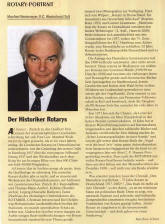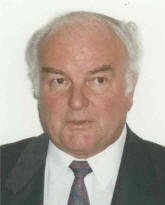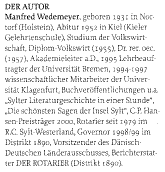|
A voluntary dissolution of the German Rotary Clubs on October
15, 1937 was the only way left for further meetings. That way no one exposed
himself to accusations of meeting illegally in a non-existent organization.
The club papers had mostly been confiscated by the Gestapo. The Rotary Clubs
in Germany had ceased to exist but several of them changed to special
discussion groups between 1937 and 1945.
The spirit of people of a common cause to stay in contact
remained. Ways and means were found to maintain personal contacts. In any
case the former Rotarians maintained the humanity in an age of bestiality.
Unfortunately the connections to clubs in other countries and to Rotary
International in Chicago were totally suspended. Therefore their goal to
further understanding beyond national boundaries had been reached.
Many German Rotarians missed their regular weekly meetings.
In a time of increasing insecurity and various interventions
by the government into the daily and professional lives it seemed necessary
to continue contacts with friends. Therefore many Rotarians agreed to
informal gatherings. In cities where once Rotary Clubs existed, circles of
friends were formed and met first in private residences and later in
restaurants and other meeting places to maintain personal contacts. Members
of the former Wilhelmshaven R.C. talked of an “Internal Emigration.” In
respect to further meetings Friedrich von Wilpert said: “The spirit of the
Rotarians outlasted the inferno.”
A special publication of the R.C. Hannover says to that:
“Even during the war the Rotarian friends never lost contact with one
another. When we met we tried to be completely open and honest in assessing
our situation and these talks among Rotarian friends were probably the only
ones that in that time period could be held in full confidentiality. We
believed in Rotary and a brighter and better future because we could again
and again experience how people in Rotary extended their hands to one
another.”
Before and during WWII the Circle of Friends met in various
places in Munich. Walter Meuschel wrote about that: “While I was in the
military, Miss Anna Weinzierl, who before the dissolution of the R.C. Munich
helped me for many years to take care of the secretarial work, continued her
work and since she was known to all Rotarians in Munich, she became a source
of news for the Rotary. She kept me informed of all Rotary news and meetings
when I returned for home leave”. In Nurnberg, the city of NS-party meetings,
the Rotarians met again after 1937 where they had first met in 1929, i.e. at
the round table of the Grand Hotel across from the Railroad Station. This
was the gathering place for all the friends that were once scattered all
over. The club minutes of meetings recall: “The voluntary dissolution of the
R.C. Nurnberg does not at all mean the end of friendly gatherings of their
members. The round table in the Grand Hotel, which can be called the point
of origin of the R.C. Nurnberg was again the place where the scattered
friends met. By invitation of its founder and president, Privy Counselor
(Geheimrat) von Petri, more and more Rotarians came to the Sunday evening
meetings, at times more than 20 men were present.
The Sunday meetings continued without interruption through
the worst days of the war, fortunately all air raid information was relayed
to the Chief of Police and the highest ranking military officer who met at
the R.C. round table. Even if there was no possibility of true Rotary
discussions, the well known circle of attendees never ceased to find a main
subject which dealt with the present situation and its concerns. Only after
the death of Mr. von Petri on May 26,1944 these meetings were suspended
especially since the destruction and the emergency in Nurnberg no longer
permitted any social gatherings”.
However a somewhat legitimate existence was still possible in
Berlin. It was also to the credit of several Berlin Rotarians, among them
especially Mr. WiIm (later a member of the R.C. Hamburg), that the
dissolution of the R. C. Berlin did not stop the friendly gatherings of the
members. First they met in the Bellevue-Strasse in the beautiful house of
the German Guild of Goldsmiths, whose president Mr. WiIm was. Since the
beginning of 1939 a larger number of members of the former R.C. and a number
of other gentlemen, who were selected according to Rotary bylaws met at the
Beuth-Table. This table was named after the Prussian Finance Minister
Christian Peter Beuth (1781-1853) who met with other men of various
occupations over lunch to discuss everyday occurrences. The Beuth-Table
still met for several years during the war and created high interest among
the Ca. 40 people gathered.
The Rotary Group that met in Hamburg from 1939 to 1944 called
itself the “Seniors Circle”. According to Rot. von der Goltz editor of the
“Hamburger Chronik” “we also found a way to meet and we have fond memories
of this time in which we were individualists in many ways but we were able
to maintain our friendship as Rotarians.” The Senior Circle met in the
restaurant “Rose” in City Hall. The second Circle met regularly, if we
remember correctly, in the Christian Hospice and the third Circle which was
more optimistic and more critical met in the hotel “Atlantik”. That is where
we experienced the war which gave us a very different outlook on life and
many unhappy days, no matter whether we remained at home or were at the
various fronts. Until the end of 1944 our scheduled meetings at the hotel
“Atlantik” never had to be cancelled due to low attendance and we always met
numerous guests who enriched our meetings. The war made our meetings more
and more difficult and they were suspended in early 1945”.
An extensive documentation of the years after the dissolution
of the R.C. Kiel has been preserved in the archives of this club. After the
dissolution in 1937 President Bernhard Goldschmidt invited all members to a
gathering to commemorate the five years of working for a common cause. At
this meeting on October 15, 1937 it was decided to continue the previous
Rotarian community in a less formal way. It was decided to take the new
name: Friday Society.
The well known historian Karl Jordan, member of the R.C. Kiel
from 1950 to his death in 1984 was a member of the Friday Society in Kiel
and recorded its history. “Mr. Goldschmidt acted as president of the society
during this time. He was assisted by Mr. Alexander Beck who had become a
Rotarian in 1936. The club met by special invitation, if possible, in
intervals of two weeks at the former Skagerrak-Club, now called FordeClub.
The high point of these meetings was mostly a lecture, in which the members,
as before in the R.C. talked not only about questions of general interest in
their trade/profession, but also about their hobbies. New friends came to
the meeting on the recommendations of long time Rotarians, first as guests,
but later on became members as well. The number of participants at these
meetings was on the average 20-25. A somewhat smaller group met for lunch at
Hoist’s Hotel. During the summer Otto invited all friends to a picnic at his
house in Kitzeberg, where he showed his expertise as a magician.
Even after the beginning of WW II life of the Friday Society
continued to meet as before, but more and more members were drafted. The
evening meetings were changed to the late afternoon because of black outs
and nightly air raids on Kiel. What made these meetings so valuable for all
members was the absolute confidentiality of all conversations. Everyone was
very careful with remarks about the political or military situation even in
the smallest gatherings and otherwise concerned that he may be called a
defeatist and brought before court. In these meetings one could speak openly
about the worries which concerned everybody during the war.
The intensification of the air war that since 1944 brought
heavy day air raids on Kiel also bad members of the Friday Society worried.
Many of them were bombed out and had to look for smaller living
accommodations in Kiel or in the surrounding area The home of the Skagerrak
Club was heavily damaged. After Hoist’s Hotel, the meeting place during the
war, was destroyed, the members met for lunch at the “Hotel Bellevue” whose
owner Paustian, a well known man from the Probstei in Holstein, was in spite
of shortage of food able to present a very good lunch. During that summer of
1944 life of the Friday Society came almost to a halt. Mr. Goldschmidt tried
to maintain contact with all friends through correspondence.”
A memo to all from Bernhard Goldschmidt of October 12, 1944
is a moving document of the closeness among the Rotarians and of the spirit
of the Friday Society:
| |
Dr. Bernhard
Goldschmidt
Barth, October 12, 1944
(4) Pommern
Dear Friends,
The fifth year of the
Friday Society is nearing its end, unfortunately it could not be
completed as we had imagined. In July Otto invited us once more to his
lovely home for a happy celebration. In retrospect it was as if fate
wanted this last gathering to have a bright and memorable ending,
remembering the uplifting and congenial times that united us In
friendship during the war. The war destroyed our home town and took not
only the place where we always met, but many of us also lost our homes.
‘Alas, all are
scattered”- that is the situation that I must sadly report at the end of
our fifth year. And that is why I consider it my first duty to bring
together all the scattered members to at least on the outside try to
pick up and maintain the connection. As far as the inner fellowship is
concerned I don’t think I have to say anything after all what we have
gone through together. I am sending this letter in the hope that the
post office will help to find everybody. I ask you to send me your new
addresses as soon as possible. Mail comes to me quickest through Hagenuk
in Kiel, plant Ravensberg. Our friend Dr. Beck is also there. I have
asked him many times to substitute for me. He can always get some
information to you.
My further obligation
is to give you the usual report of the completed fifth year of our
Friday Society. That is especially difficult because I lost all records
when a part of the administration building at Hagenuk was destroyed.
Therefore I have to write down everything from memory and ask you to
excuse any inaccuracies. This year we heard the following lectures:
November 1943 Sauermann
“Early works in applied art In Schleswig-Holstein”
December 1943 Anschutz:
“Amazing and miraculous happenings in surgery”
January 1944 Mohr:
“Topical questions of war at sea”
February 1944 ??
March 1944 Goldschmidt:
“How do the Americans live?”
April 1944 Gripp: “Trip
to Greenland”
May 1944 Huuke; “Goethe
and the Theater in Bad Lauchstadt”
June 1944 Kroebel
“Modem H1 Frequency” Technique”
July 1944 Otto:
“Gartenfest Kitzeberg”
The average attendance
in our fifth year was 20. That means the number has increased.
I conclude this letter
with best wishes to every one and hope that we will be able to meet
again under better circumstances. I combine my wishes with greetings and
In the hope of your well being.
Heil Hitler
signed B.
Goldschmidt |
|
Meeting places of Rotarian friends were everywhere in the
Third Reich, not only in the above mentioned cities. They all felt the need
to maintain the exchange of thoughts and ideas. The mentioned examples for
the activity and continuity of the Rotarian Circles in the Nazi-State
especially from 1937 to 1945 show clearly that the German R.C. kept up their
spirits even after their dissolution. Officially they did not exist anymore
but in their core many of them acknowledged consequently even after 1937 the
idea of Rotary, the good of the people, service to your neighbor, to friends
and to humanity. The aims of the Rotary were kept up and in everybody’s
mind. They waited for the right time in which the Rotary in Germany could be
reestablished.
| |
Author of the book (in German):
1927 – 2002 DEN MENSCHEN VERPFLICHTET 75
JAHRE ROTARY IN DEUTSCLAND
(1927 – 2002 Mankind is Our Business
75 Years of Rotary in Germany)
© 2002 by DER ROTARIER Verlags-GmbH,
Hamburg und Manfred Wedemeyer
ISBN 3-00-009212-9 (€ 24.00 + € 10.00
S&H)
|
|



